Ernest Scott - A Spitfire pilot in the Battle of Britain.
As one of 'The Few', he fought and died over 80
years ago, in the skies above Southern England.
Had we lost this battle, an invasion may well have been next.
The Biography
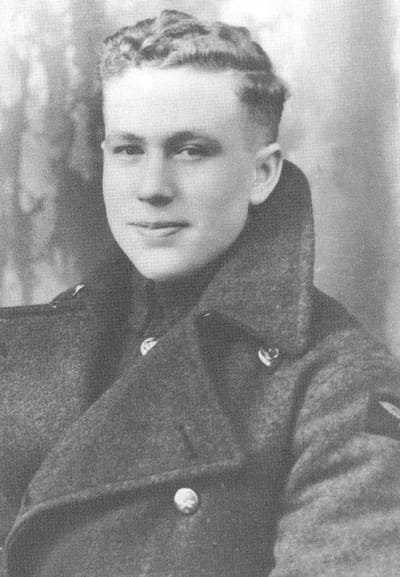
'The Few', as they were described by Winston Churchill, were the brave young men who fought in their Spitfires and Hurricanes to defend our nation, against the might of the Luftwaffe, in the dark days of 1940, during the Battle of Britain.
Ernest Scott died in his Spitfire on 27th September 1940, aged just 23.
But the story does not end with his passing.
He that was lost, became found.
Biography compiled by Jack Bayes
Early years
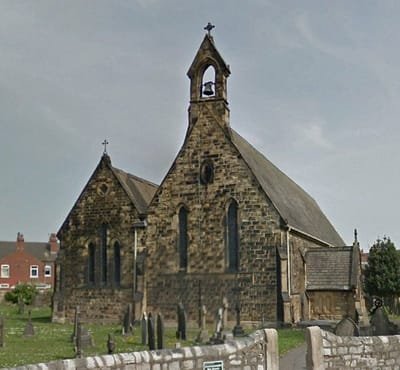
In 1911, the census of that year shows that Richard and Elizabeth Martha were living at 37 Low Road, Balby, which is a western suburb of the town of Doncaster.
(The house in Low Road where they lived is long gone, the site now lies under a lighting retail business. The site is at Grid Ref. SE563013).
Richard was a brick worker, (Balby Brickworks was just down the road in those days. The site is now a small industrial estate, at Grid Ref. SE563007).
Their first three children were;
Arthur Lesley, b.c.1909, Norah, b.1910 and then Aston came along in 1913.
Their fourth child, Ernest was born, on the 30th of December, 1916. He was christened at the Church of St. John the Evangelist, Balby, on 24th of January, 1917.
The Church was on the other side of the main Balby Road to where they lived and is pictured, right, (image c/o Google Earth).
An hiatus caused Elizabeth Martha, with Ernest as a babe in arms, to leave the family and live with Lewis Kent in Mansfield, Nottinghamshire.
This must have been in 1917 or 1918. She was to live with Lewis Kent for the rest of her life.
Lewis and Elizabeth had two children together; Irene (1920-2013) and Albert Lewis (1922-1997).
Richard Scott died in 1942, so Elizabeth and Lewis were able to get married, which they did in the following year.
Ernest was educated at St. Peter's School, Mansfield and later at St. John's College, York. He must have been clever enough to have got a scholarship to go to that college.
He was then employed as a fitter in an engineering works, until in 1935, he joined the Royal Air Force.
Service in the RAF
Ernest Scott - RAF No. 525152
By the look of it, he did well in his early years in the RAF.
He had advanced to Aircraftsman Grade 1 by 1937 and Leading Aircraftsman in 1938.
He is pictured (top), working on the engine of a Handley Page Heyford, (a biplane bomber of early 1930's vintage).
He was successful in being selected for pilot training and got his 'Wings' at RAF Lossiemouth.
15 Flying Training School was based there from May 1939, equipped with Harvards.
By now, promoted to Sergeant Pilot, he successfully converted to the Supermarine Spitfire at RAF Aston Down on 24th February 1940.
In the March, he was transferred to 222 Squadron, flying Spitfires out of RAF Duxford in Cambridgeshire.
No doubt, he would have participated in operations covering the withdrawal of British troops from Dunkirk.
On the lower photo, he is pictured standing alongside the C.O.'s Spitfire.
By the look of it, he did well in his early years in the RAF.
He had advanced to Aircraftsman Grade 1 by 1937 and Leading Aircraftsman in 1938.
He is pictured (top), working on the engine of a Handley Page Heyford, (a biplane bomber of early 1930's vintage).
He was successful in being selected for pilot training and got his 'Wings' at RAF Lossiemouth.
15 Flying Training School was based there from May 1939, equipped with Harvards.
By now, promoted to Sergeant Pilot, he successfully converted to the Supermarine Spitfire at RAF Aston Down on 24th February 1940.
In the March, he was transferred to 222 Squadron, flying Spitfires out of RAF Duxford in Cambridgeshire.
No doubt, he would have participated in operations covering the withdrawal of British troops from Dunkirk.
On the lower photo, he is pictured standing alongside the C.O.'s Spitfire.
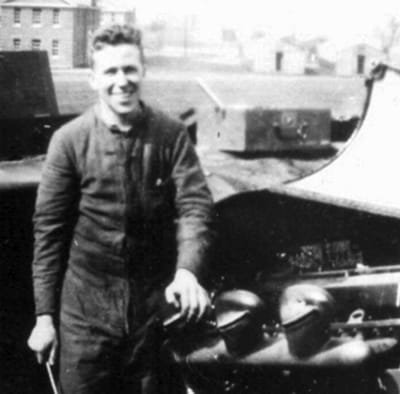
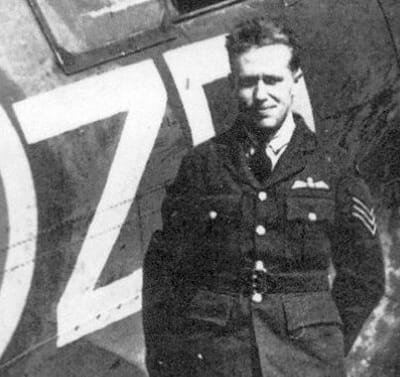
Battle of Britain
At the end of August, 222 Squadron were transferred to RAF Hornchurch, in Essex, from where they were to take active part in the Battle of Britain.
RAF Hornchurch was an airfield in the parish of Hornchurch, Essex (now in the London Borough of Havering in Greater London), located to the southeast of Romford. The airfield was known as Sutton's Farm during the First World War, when it occupied 90 acres (360,000 m2) of the farm of the same name. It was used for the protection of London, being 14 miles (22.5 km) east north-east of Charing Cross.
In the next few weeks, Scott accumulated an impressive number of victories against the enemy.
2nd September - Dornier 17 - damaged
3rd September - A Dornier 17 and an Me.109 - both destroyed.
5th September - 2 probables, an Me.110 and an Me.109.
7th September - An Me.110 - destroyed.
9th September - Two Me.109s - damaged.
11th September - A Heinkel 111 and another (even after his cockpit hood was shattered by enemy fire), - both shared destroyed.
27th September - An Me.109 - destroyed.
Scott was only to verbally report his Me.109 kill at the end of the morning of the 27th, intending to hand his written report sheet in later.
He stowed the sheet in his boot and set off again in Spitfire P9364 in the afternoon.
By this time he had enough kills to be regarded as a Fighter Ace.
But that fateful afternoon, he was not to return.
He came into the gun-sights of another fighter ace.
It appears he became the 41st victim of Luftwaffe ace, Werner 'Vati' Molders.
Major Molders achieved 115 aerial victories during his career.
He was the highest-ranking German ace at the time of his death in an aircraft accident, later in the war.
I found his photo (below) on a Battle of Britain display at the RAF Museum at Hendon.
Scott's aircraft crashed at full speed into the Kent countryside.
A Maintenance Unit Inspector called to the scene, recovered a piece of metal bearing the serial number P9364.
But owing to the failure of the Air Ministry to link such compelling evidence with the disappearance of Scott, his parents were told his Spitfire had been lost in combat over the Channel.
He was officially - Missing.
His name was therefore inscribed on the Runnymede memorial, for those lost with no known grave*.
At this time, this appeared to be the end of his story.
--------------------------------------------------------------------
*You will also find his name on Panel 19 of the Battle of Britain London Monument. The monument is sited on the Victoria Embankment, (north bank of the Thames), about 200 metres from Westminster bridge. It is almost directly opposite the Millennium Wheel, (the huge London Eye Ferris wheel), which is on the south bank of the Thames.
We visited this monument on 29 July 2021. I took the photo of his name on Panel 19, this is shown below.
RAF Hornchurch was an airfield in the parish of Hornchurch, Essex (now in the London Borough of Havering in Greater London), located to the southeast of Romford. The airfield was known as Sutton's Farm during the First World War, when it occupied 90 acres (360,000 m2) of the farm of the same name. It was used for the protection of London, being 14 miles (22.5 km) east north-east of Charing Cross.
In the next few weeks, Scott accumulated an impressive number of victories against the enemy.
2nd September - Dornier 17 - damaged
3rd September - A Dornier 17 and an Me.109 - both destroyed.
5th September - 2 probables, an Me.110 and an Me.109.
7th September - An Me.110 - destroyed.
9th September - Two Me.109s - damaged.
11th September - A Heinkel 111 and another (even after his cockpit hood was shattered by enemy fire), - both shared destroyed.
27th September - An Me.109 - destroyed.
Scott was only to verbally report his Me.109 kill at the end of the morning of the 27th, intending to hand his written report sheet in later.
He stowed the sheet in his boot and set off again in Spitfire P9364 in the afternoon.
By this time he had enough kills to be regarded as a Fighter Ace.
But that fateful afternoon, he was not to return.
He came into the gun-sights of another fighter ace.
It appears he became the 41st victim of Luftwaffe ace, Werner 'Vati' Molders.
Major Molders achieved 115 aerial victories during his career.
He was the highest-ranking German ace at the time of his death in an aircraft accident, later in the war.
I found his photo (below) on a Battle of Britain display at the RAF Museum at Hendon.
Scott's aircraft crashed at full speed into the Kent countryside.
A Maintenance Unit Inspector called to the scene, recovered a piece of metal bearing the serial number P9364.
But owing to the failure of the Air Ministry to link such compelling evidence with the disappearance of Scott, his parents were told his Spitfire had been lost in combat over the Channel.
He was officially - Missing.
His name was therefore inscribed on the Runnymede memorial, for those lost with no known grave*.
At this time, this appeared to be the end of his story.
--------------------------------------------------------------------
*You will also find his name on Panel 19 of the Battle of Britain London Monument. The monument is sited on the Victoria Embankment, (north bank of the Thames), about 200 metres from Westminster bridge. It is almost directly opposite the Millennium Wheel, (the huge London Eye Ferris wheel), which is on the south bank of the Thames.
We visited this monument on 29 July 2021. I took the photo of his name on Panel 19, this is shown below.


The long road to recovery
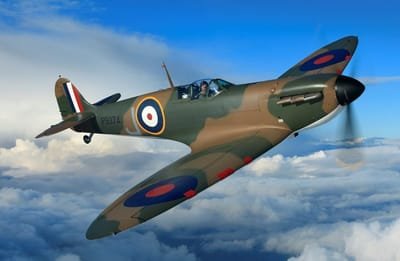
It had buried itself deep into a field at Greenway Court, Hollingbourne in Kent.
The picture shown is that of an identical Spitfire Mk 1a to P9364.
They had tried many times to get Sergeant Scott recovered, but the farmer at that time had been told that it was the wishes of the pilot's family that he be left where he crashed, (we know now this was not true).
Al Brown was adamant it was Sgt Scott, but the problem was they could not trace his family and desperately needed the backing of his family if they were to get anywhere.
This went on for years.
(They were looking for a Scott family in Mansfield. The Scotts were in Balby. His Mother in Mansfield, was now called Kent).
Then in 1990, Al had a break-through.
He put an ad in the Nottingham Observer asking for any information on the whereabouts of Sgt Scott’s family.
They soon had a reply from Sgt Scott’s half-brother Albert Kent. They wrote back giving Albert the telephone number of Malcom Pettit.
A couple of days later Pettit got a phone call from Albert.
When he was told they knew where Ernest was, Albert broke down and cried, he then told Pettit that his Mother had been informed that her son had gone missing over the Wash, off the East Coast. In fact, Al Brown had a copy of the Kent Police reports of downed RAF Fighters, which clearly stated Spitfire P9364 had crashed at Greenway Court, Hollingbourne.
The sad thing is Sgt. Scott’s mother died in 1971, not knowing what had really happened to her son.
Two days later, Albert came down to see Pettit, who took him to Greenway Court and showed him the field where he was convinced his brother’s remains were buried.
Albert was in tears, he could not believe it, how cruel the authorities had been to his mother, after all, her son had given his life in defence of his country. Pettit took Albert to the farm house to see the land owner, Hughie Batchelor, who was not the easiest of men to deal with.
They knocked on his door, the door opened and there stood a rough and ready looking man.
Pettit explained who he was and told him who Albert was.
Albert put his hand in his pocket and pulled out a photo of his brother and said, "Please sir, can you let this man recover my brother's Spitfire and his remains?".
Batchelor replied, “Have you got a JCB?”
They replied that they didn't.
He said, “I have, you can use that and I have a driver who can do it tomorrow Saturday.”
They both left very happy, when Pettit got back to Tonbridge, he dropped Albert off at his hotel and went home.
As Pettit walked in to his front door, his wife said Hughie Batchelor had phoned and said you are not to go anywhere near that field on Saturday.
Pettit then had to phone Albert and tell him what Batchelor had said - he was heartbroken.
Pettit told Albert he could do no more, Albert would have to write to the powers that be.
Albert went back home to Mansfield and started writing, initially without success.
In the end, he wrote to the then Prince of Wales, (now, of course, HRH King Charles III).
A few days later, things started to happen, the Police cordoned off the whole area and an RAF recovery team moved in.
So, on 15/16th December 1990, a team from the RAF's Aircraft Salvage and Transportation Flight at RAF Abingdon finally started to dig up the wreck of Spitfire P9364.
As was policy, they stopped extracting wreckage when they found the remains of the pilot. Documents found, confirmed that it was indeed, Ernest Scott.
--------------------------------------------------
(Note: Most of the above information was taken from the Tonbridge Battle of Britain Museum site.)
The last goodbye
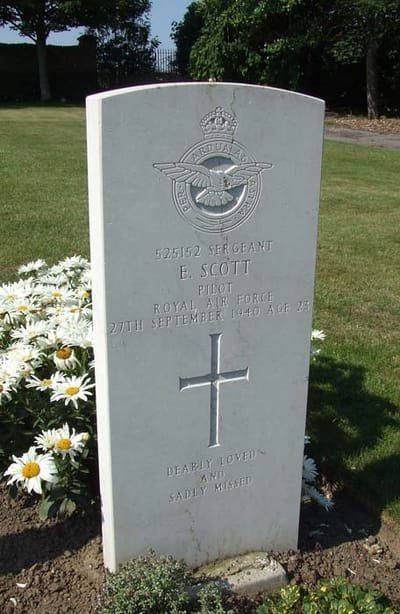
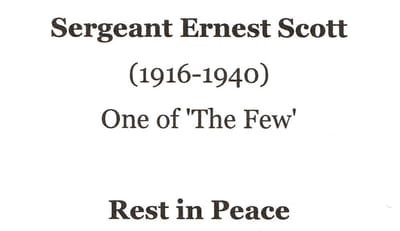
Malcom Pettit was there and met many of Ernest's old mates from 222 Squadron, even the Rigger who was the last man to strap him into the cockpit for his last fatal flight. This was the late Arthur 'Dave' Davis.
The C.O. of nearby RAF Manston also attended, saying,
"Sergeant Scott did not want or seek to lose his life. But he was willing to risk it for things that matter. It was taken from him on the threshold of achievement. But in his short time span, he did more than most of us. It is our honour to recognise that today. He was a gentle and sensitive young man who knew the ideals he was fighting for. He is no longer missing."
Winston Churchill said the telling phrase to describe how these people should be remembered.
"Never was so much owed, by so many, to so few "
Links & Notes
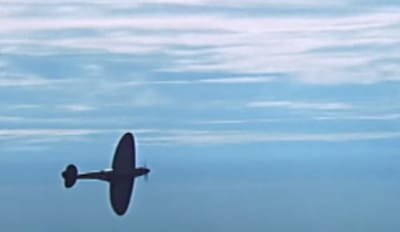
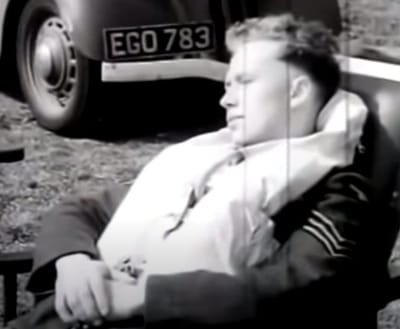
The following , in bold type, are links to other pages on the internet regarding Ernest Scott.
I used these to glean the information given on this website, some of the information I used and some I missed out for brevity.
I've added new links to the Hornchurch Aerodrome Historical Trust, who have recently been in contact. (Mar 2021). Also in contact were the guys at the Museum at Hawkinge, near Folkstone. Somehow, the wreckage of Scott's plane ended up there.
Spinks 1
Spinks 2
Battle of Britain Monument
Tonbridge 1
Tonbridge 2
RAF Hornchurch (Facebook)
Hornchurch Aerodrome Historical Trust
Kent Battle of Britain Museum at Hawkinge
222 Squadron - a short film showing a 'scramble'. Ernest Scott is shown in first few seconds of the film, (a still of which is shown right).
I also used sites like Ancestry to find more biographical information, e.g. his birth location.
Also, see my genealogical Webb site.
The Ernest Scott entry on the 'Find a Grave' web site can be found here.
NOTES
You may ask, what has Ernest Scott to do with me?
My wife is his 3rd cousin, once removed. (See my Webb site).
We know Balby well, as our daughter and her family live nearby.
My Father was a contemporary of Ernest Scott in the RAF, having joined in the same year of 1935.
(Thankfully, Dad survived WW2).
It's strange that two separate branches of the Webb family, should both end up in Doncaster.
They share a common ancestor, William Webb, (1787-1859), a Waterman living in the historic town of Greenwich, Kent.
Ernest's Mother, Elizabeth Martha Webb, was christened in Leytonstone, East London on 29 Jun 1884, when she was 13 days old.
From then on, she seems to be missing from the public record, until 5 July 1902 when, aged 18, she married Robert Scott in Doncaster.
Elizabeth Martha's elder brother, William Henry Webb, had been living in Doncaster from at least 1890.
One day, I suppose we'll find out where she had been, and how and why she and her brother got to Doncaster.
We ourselves arrived in the Doncaster area from Gloucestershire in 2004.
Then, in the Summer of 2020, we discover that members of my wife's Webb family have been here for 120 years.
My wife must have quite a few distant cousins, of the Webb and Scott ilk, around Doncaster that we have yet to meet.
What a small world.
We are all indebted to the likes of Ernest Scott, who gave everything he had for our country.
---------------------------------
Postscript
Despite all the information to be found on the web, I thought a corrected, straightforward account of Ernest Webb's life, death, loss and recovery needed to be written.
Here it is.
Jack Bayes
August 2020
(Updates in March, June and August of 2021 and in 2022)
Contact address

If you would like to contact me, here's my new E mail address.
My genealogical web site, (which includes a Webb page), is here.
My genealogical web site, (which includes a Webb page), is here.
